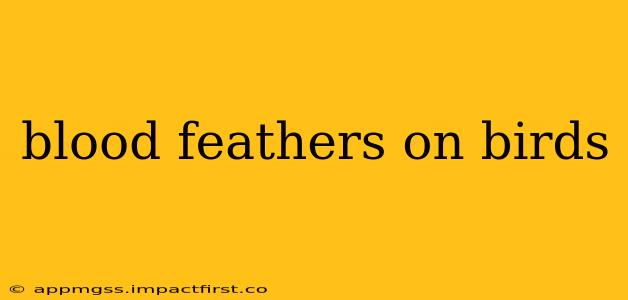Blood feathers, also known as pin feathers or growing feathers, are a normal part of a bird's molting process. These feathers are still developing and have a blood supply running through the shaft. While seemingly alarming due to their blood-filled quills, they're a crucial stage in feather development and a vital aspect of avian health. Understanding blood feathers helps bird owners and enthusiasts provide appropriate care and recognize potential problems.
What are Blood Feathers?
Blood feathers are essentially feathers in their growth phase. They start as a small, fleshy protrusion from the skin, gradually developing into the familiar feather structure we recognize. During this development, the feather's shaft contains blood vessels that nourish the growing barbules and rachis (the central shaft). This makes them sensitive and vulnerable to damage. Once the feather is fully grown, the blood supply retracts, leaving behind a fully formed, non-bleeding feather.
Why Do Birds Have Blood Feathers?
The presence of blood feathers is a natural and essential part of a bird's life. The blood supply within the developing feather is critical for its growth and development. The blood delivers the nutrients and building blocks necessary to create the complex structure of a mature flight or contour feather. Without this blood supply, the feather wouldn't develop properly. This process is repeated throughout a bird's life as they molt, regularly replacing old, worn feathers with new ones.
Are Blood Feathers Dangerous?
While blood feathers are a natural part of a bird's life cycle, they can pose risks if damaged. A broken blood feather can cause significant bleeding, potentially leading to anemia or even death in smaller birds. The bleeding is often more profuse than one might expect due to the direct blood supply to the feather shaft. This is especially concerning for birds with compromised immune systems or those prone to other health issues. Therefore, handling birds during molting should be done with extra care and awareness.
How to Tell if a Blood Feather is Damaged?
A damaged blood feather is easily identifiable. It will be noticeably bent or broken, often with visible bleeding at the base where the feather emerges from the skin. The bird may exhibit signs of distress, such as excessive preening, restlessness, or lethargy.
What to Do if a Bird has a Broken Blood Feather?
If you discover a broken blood feather on your bird, prompt action is essential. Do not attempt to pull the feather out. This will likely increase bleeding and cause unnecessary pain. Instead:
- Stop any bleeding: Gently apply pressure to the base of the feather using a clean cloth or cotton ball.
- Seek veterinary care: Contact an avian veterinarian as soon as possible. They have the expertise and tools to properly address the situation, potentially cauterizing the blood vessel to stop the bleeding and ensure the bird's well-being. Delaying treatment could have serious consequences.
How Often Do Birds Get Blood Feathers?
The frequency with which birds get blood feathers depends on several factors, including the species, the bird's age, and its overall health. Some birds molt more frequently than others. However, it's a continuous process throughout a bird's life, typically occurring in cycles. You may notice more blood feathers during peak molting periods.
What are the signs of a problem with a bird's blood feather?
Signs of a problem related to a blood feather can include: Excessive bleeding from a feather shaft that doesn't stop after gentle pressure; lethargy or weakness in the bird; the bird showing signs of pain or discomfort around the affected area; and the development of an infection at the base of the feather.
What can I do to prevent problems with blood feathers?
While you can't prevent blood feathers from appearing, you can minimize risks by: Handling your bird gently, especially during molting periods; providing a stress-free environment; ensuring a balanced diet; and seeking veterinary care at the first sign of a problem with a feather.
In conclusion, understanding blood feathers is crucial for responsible bird ownership. While their presence indicates a natural process, prompt action in case of damage is paramount for ensuring the well-being of your feathered companion. Regular observation during molting periods and quick access to avian veterinary care are key elements in preventative care.
